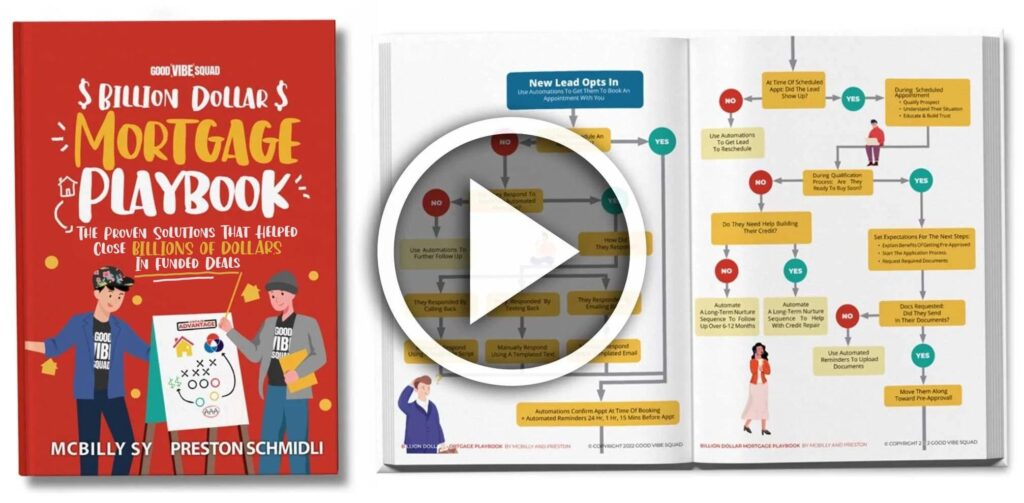Crafting pre-approval letters is an essential skill for any mortgage loan originator. A pre-approval letter needs to be clear, concise, and convincing. It should highlight the client’s financial stability, creditworthiness, and ability to secure a mortgage loan. In this article, we will discuss everything you need to know about pre-approval letters, why they matter to buyers and sellers, and how to craft a compelling pre-approval letter.
Key Takeaways
- Pre-approval letters are crucial for homebuyers in a competitive housing market.
- A pre-approval letter shows sellers that your client is a serious buyer and has the financial ability to follow through on their offer.
- Crafting a convincing pre-approval letter is an essential skill for any mortgage loan originator.
Get Our Billion Dollar Mortgage Playbook
Get the proven strategies that helped close Billions of dollars in funded deals!
The Weight of Pre-Approval Letters
As a mortgage loan originator, you know that a pre-approval letter is a crucial document in the homebuying process. It is a conditional commitment from a lender to potentially approve a borrower’s loan in the future based on certain assumptions. The pre-approval letter is not a guarantee but still carries significant weight in the eyes of the seller and real estate agent, as it shows that the borrower is a serious buyer with the assumed financial ability to move forward with a purchase.
Essential Components and What They Signify
A pre-approval letter must contain essential components that signify the borrower’s eligibility for a loan. These components include:
- Maximum Loan Amount: This is the maximum amount of money the lender is willing to lend the borrower, given that certain criteria are met.
- Loan Type: This specifies the type of loan the borrower is approved for, such as a conventional, FHA, or VA loan.
- Interest Rate: This is the interest rate the borrower is conditionally or likely to be approved for, based on current market conditions and the borrower’s credit score.
- Loan Term: This is the length of time the borrower has to repay the loan, typically 15 or 30 years.
- Expiration Date: This is the date by which the borrower must close on the loan, after which the pre-approval letter is no longer valid.
These components signify the borrower’s eligibility for a loan and provide the seller and real estate agent with a clear understanding of the borrower’s financial situation.
Importance of Clarity and Specificity
Clarity and specificity are essential when it comes to pre-approval letters. The letter must be clear and specific in its language, leaving no room for ambiguity or confusion. It must also be specific to the borrower’s financial situation, taking into account their credit score, income, and debt-to-income ratio.
A vague or generic pre-approval letter can lead to misunderstandings and delays in the homebuying process. It can also cause the seller and real estate agent to question the borrower’s financial ability to close on the loan, leading them to consider other offers.
Why Pre-Approvals Matter to Sellers
As a mortgage loan originator, you know that pre-approval letters are essential for your clients to secure a mortgage. But did you know that pre-approval letters are also crucial for sellers? Here are two reasons why:
Perceived Commitment and Seriousness
When a seller receives an offer from a prospective buyer, they want to know that the buyer is serious and committed to the purchase. A pre-approval letter shows that the buyer has taken the time to speak with a lender and has been tentatively approved for a mortgage. This indicates to the seller that the buyer is serious about purchasing their home and has taken steps to ensure they can obtain financing.
Confidence in a Prospective Buyer’s Financial Standing
A pre-approval letter provides the seller with confidence that the prospective buyer has the assumed financial means to purchase the home. The letter outlines the maximum amount of money the lender will allow the buyer to obtain for their mortgage. This gives the seller peace of mind that the buyer has the financial standing to follow through with the purchase.
Crafting a Convincing Pre-Approval Letter
When crafting a pre-approval letter, there are a few things you should keep in mind to make it as convincing as possible. Here are two sub-sections to consider:
Using professional language and templates
One way to ensure that your pre-approval letter is professional and convincing is to use appropriate language and templates. Avoid using overly casual language or slang, and instead, use professional language that conveys your expertise and credibility. Additionally, consider using a pre-approval letter template to ensure that you include all necessary information and that your letter looks professional and polished.
When choosing a template, make sure it includes all the necessary sections, such as the loan amount, the loan type, the interest rate, and any conditions or contingencies. You can also consider customizing the template with your own branding or logo to further enhance the professional feel.
Including necessary details without oversharing
While it’s important to include all necessary details in your pre-approval letter, it’s equally important to avoid oversharing or including irrelevant information. Stick to the facts and include only the information that is necessary to convey your message and establish your credibility.
For example, you may want to include details about the borrower’s income, credit score, and debt-to-income ratio, as well as any conditions or contingencies that may apply to the loan. However, you should avoid including personal information or details that are not relevant to the loan application.
Potential Pitfalls and How to Avoid Them
As a mortgage loan originator, it’s important to be aware of potential pitfalls that can arise during the pre-approval process and how to avoid them. Here are a few things to keep in mind:
Avoid Vague Language
When communicating with potential borrowers, it’s important to use clear and concise language. Avoid using vague or ambiguous terms that could be misinterpreted. For example, instead of saying “you may be eligible for a pre-approval,” say “based on your credit score and income, you are pre-approved for a mortgage loan up to $X amount.” This type of clear communication can help avoid confusion and ensure that borrowers understand their options.
Avoid Overpromising
It’s important to be honest and upfront with borrowers about their pre-approval status. Avoid overpromising or making guarantees that you can’t keep. For example, don’t promise a borrower that they will be approved for a certain loan amount if you’re not confident that they will meet the lender’s underwriting requirements. Instead, be transparent about the factors that could impact their loan approval and work with them to find a solution that meets their needs.
Avoid Incomplete Documentation
One of the most common pitfalls during the pre-approval process is incomplete documentation. Make sure that borrowers understand exactly what documentation they need to provide and when it’s due. Provide a clear checklist of required documents and follow up with borrowers to ensure that they have submitted everything on time. Incomplete documentation can delay the pre-approval process and create frustration for both you and the borrower.
The Role of Digital Platforms in Creating and Delivering Pre-Approval Letters
Digital platforms have revolutionized the mortgage industry by providing a seamless and efficient way to create and deliver pre-approval letters. With the help of digital platforms, mortgage loan originators can provide their clients with personalized pre-approval letters in a matter of minutes rather than days or weeks.
One of the main advantages of using digital platforms for pre-approval letters is the ability to gather client information quickly and accurately. Instead of relying on paper applications and manual data entry, digital platforms allow clients to submit their information online, which is then automatically populated into the pre-approval letter.
Another advantage of using digital platforms for pre-approval letters is the ability to deliver them quickly and securely. Rather than relying on traditional mail or fax, digital platforms can deliver pre-approval letters via email or secure online portals.
From Pre-Approval to Long-Term Client
Remember: clients are well within their rights to find another lender to work with, even after a pre-approval letter has been issued.
Providing excellent customer service is key to building rapport and establishing the foundations of a long-term client relationship. By being knowledgeable, confident, and neutral, you can help your clients navigate the home-buying process with ease and make the dream of homeownership a reality.
Meet the #1 Lender-Preferred Lead & Marketing Solution
Looking for a compliant lead-gen, marketing, CRM, and coaching solution that prioritizes trust-based marketing and relationship-building? You’re in the right place. We can deliver qualified leads to your pipeline as soon as you go live with our program. These leads are exclusive to you and only ever come from reputable sources.
We also show you how to nurture leads and prospects with our proprietary nurture system that boosts your trust and credibility through texts, emails, and videos. The best part? We handle all the trust-based marketing for you, so you have more time and more freedom to focus on other revenue-generating activities for your business.
Did we also mention round-the-clock access to our private community of LOs to troubleshoot with, in addition to hands-on support from our rockstar Member Success team?







